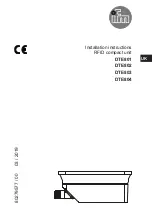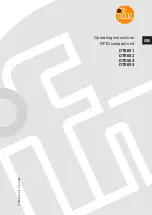
6 000 836 999
2013-05-08
|
Bosch Automotive Diagnostics Equipment (Shenzhen) Limited
14|��������|Operation
en
6.�
�ehiclelifting
DANGER–Riskofvehiclefallingortilting!
Risk of (fatal) injury on lifting (or raising) the
runway.
¶
Make sure there is no-one in the vehicle or
in the area of the lifting platform.
¶
Keep away from the support arms and the
vehicle.
¶
Observe the support arms, the jacking
points and the vehicle.
1.
Release the locking pawls by pulling release handle
and press the control button upwards for approx. 1
second.The support arms move upwards for as long
as the control button being pressed upwards.
2.
Stop and check locking of the support arms. If nec-
essary, move the support arm slightly to engage it.
3.
Raise the vehicle until the tires are no longer in con-
tact with the ground. Then stop.
!
If the front and rear axles are not raised evenly, the
vehicle is incorrectly positioned. In this case: Lower
the support arms re-position the vehicle and repeat
the lifting operation.
4.
Check that the mounts are in firm contact with the
jacking points.
!
If the vehicle is not stable: Lower the support arms,
re- position the vehicle and repeat the lifting opera-
tion.
5.
Continue raising the vehicle after ensuring its stabil-
ity.
6.
Raise as far as the required height or to the upper.
"
The lifting platform is raised and locked.
6.6
Duringworkonvehicle
DANGER–Riskofvehiclefallingortilting!
Risk of (fatal) injury whilst using lifting platform.
¶
Make sure all the four mounts are in firm
contact with the jacking points recom-
mended by the vehicle manufacturer before
standing under the vehicle.
¶
Avoid subjecting the vehicle to severe vibra-
tion.
¶
Never cause the vehicle or support arms to
vibrate.
¶
Always use safety devices if heavy compo-
nents (e.g. engine, transmission) are being
removed or attached. Fit the safety devices
to reach towards the vehicle rather than
lowering the vehicle onto the safety devices.
6.7
�ehiclelowering
DANGER–Riskofvehiclefallingortilting!
Risk of (fatal) injury on lowering the support
arms and the vehicle.
¶
Check that the mounts are in firm contact
with the jacking points.
¶
Avoid abrupt movement of the support arms
and the vehicle.
DANGER–Riskofcrushingwhenlowering
liftingcarriage!
Risk of (fatal) injury on lowering the lifting car-
riage.
¶
Make sure there is no-one in the vehicle or
in the area of the lifting platform.
¶
Make sure there are no objects in the area
of the lifting platform.
¶
Keep away from the lifting platform.
1.
Remove all non-secured tools and other objects from
the vehicle and the lifting platform.
2.
Release the locking pawls by pulling release handle,
then press the lifting down lever to low lifting car-
riage.
!
Lifting up the lifting carriage a little bit if you can’t
release the locking pawls.
3.
On approaching the foot protection safety level
(height of approx. 200 mm), keep a visual check on
the area beneath the lifting platform.
!
Stop the lowering operation if necessary and elimi-
nate the hazard.
4.
Move the lifting platform completely down if the area
is safe.
The vehicle is then standing on the ground again.
The support arms are unlocked.
"
The lifting platform and vehicle are now fully low-
ered.
6.8
Drivingthevehicleout
1.
Make sure that the lifting platform is completely
lowered.
2.
Turn the support plates to lower completely.
3.
Swivel the support arms to maximum clearance
width.
4.
Ensure that the exit area is unobstructed.
5.
Drive the vehicle out of the lifting platform in a
straight line.
"
The lifting platform is now empty.
6.9
Switch-off
Switch off the VLH 2235H by way of the main switch.
1.
Set the main switch to the OFF (O) position.
2.
Secure to prevent unauthorized switch-on.
"
Lifting platform is deactivated.















































